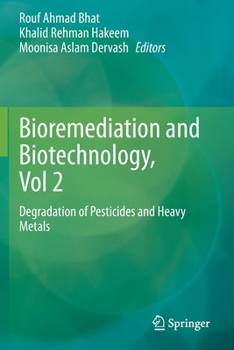Bioremediation and Biotechnology, Vol 2: Degradation of Pesticides and Heavy Metals
Select Format
Select Condition 
Book Overview
1. Current status and challenges of pesticide pollution in aquatic environs
Ricardo Antunes Azevedo; Department de Genetica Escola Superior de Agricutura Luiz de Queiroz, Universidade de sao Paulo, SEP 13418-900, Piracicaba, SP, Brazil; raazeved@esalq.usp.br
2. Concerns and threats of Heavy metal contamination on aquatic ecosystems
Tihana Tekli; Department of Agroecology, Faculty of Agriculture, University J. J. Strossmayer in Osijek, Kralja Osijek, Croatia; tteklic@pfos.hr
3. Causes and effects of Pesticide and metal pollution on different ecosystems
Sartaj Hussain Bhat; Gifu University, 1-1 Yanagido, Gifu City-501-1193, Japan, email: sartajbhat88@gmail.com
4. Traditional methods for evaluation of pesticide and metal pollution load
Moshe Sagi; The Jacob Blaustein Institutes for Desert Research, The Albert Katz Department of Dryland Biotechnologies, Ben-Gurion University, PO Box 653, Beer Sheva 84105, Israel; gizi@bgu.ac.il
5. Role of Modern innovative techniques for assessing and monitoring Heavy metal and pesticide pollution in different environs
Rocio Leyva; Departamento de Fisiolog?a Vegetal, Facultad de Ciencias, Universidad de Granada, 18071 Granada, Spain; roleyva@correo.ugr.es
6. Global scenario of remediation techniques to combat pesticide pollution
Monica Butnariu
Banat's University of Agricultural Sciences and Veterinary Medicine "King Michael I of Romania" from Timisoara, 300645, Calea Aradului 119, Timis, Romania (email: monicabutnariu@yahoo.com)
7. Microbial biota for degradation of persistent pollutants
Fernanda Maria Policarpo Tonelli
Department of Cellular Biology, Institute of Biological Science, Federal University of Minas Gerais, Belo Horizonte, Brazil
email: tonellibioquimica@gmail.com8. Mycoremediation: a sustainable approach for pesticide pollution abatement
Monica Butnariu
Monica Banat's University of Agricultural Sciences and Veterinary Medicine "King Michael I of Romania" from Timisoara, 300645, Calea Aradului 119, Timis, Romania (email: monicabutnariu@yahoo.com)
9. Micro-algae for abatement of aquatic pesticide pollution
Sha Liu; Department of Plant Soil and Microbial Sciences, Michigan State University, East Lansing, MI 48824, United States; Merewitz@msu.edu
10. Bio-pesticides: Application and Possible Mechanism of Action
Muneeb U Rehman
Department of Clinical Pharmacy, College of Pharmacy, King Saud
Email: muneebjh@gmail.com
11. Bio-fertilizers: Ecofriendly approach for plant and soil environment
Jian-Kang Zhu; Shanghai Center for Plant Stress Biology and Centre for Excellence in Molecular Plant Sciences, Chinese Academy of Sciences, Shanghai 201602, China; jkzhu@purdue.edu12. Application of macrophytes environmentally sound technique for cleaning of polluted environs
Olga Natalia Bustos L?pez
Universidad Aut?noma de Tamaulipas, M?xico mail: olga.bustos@uat.edu.mx
13. Phytoremediation: an ecofriendly approach for restoration of polluted environs
Farhana Maqbool
Department of Biochemistry, Hazara University, Mansehra, 21300, KPK, Pakistan, email: drfarhana@hu.edu.pk
14. Phytoremediation of Heavy Metals Using Salix (Willows)
Khursheed Ahmad Wani
Department of Environmental Science, Govt Degree College Bijbehara (India) email: kuurshidevs@gmail.com
14. Rhizofiltration: a tool for cleaning the pollution
N. Malash; Faculty of Agriculture, Menofiya University, Shibin El-Kom, Egypt; n_malash@hotmail.com
15. Role of macrophytes in spontaneous lacustrine p
Related Subjects
Engineering Nature Science Science & Math Science & Scientists Science & Technology Technology




